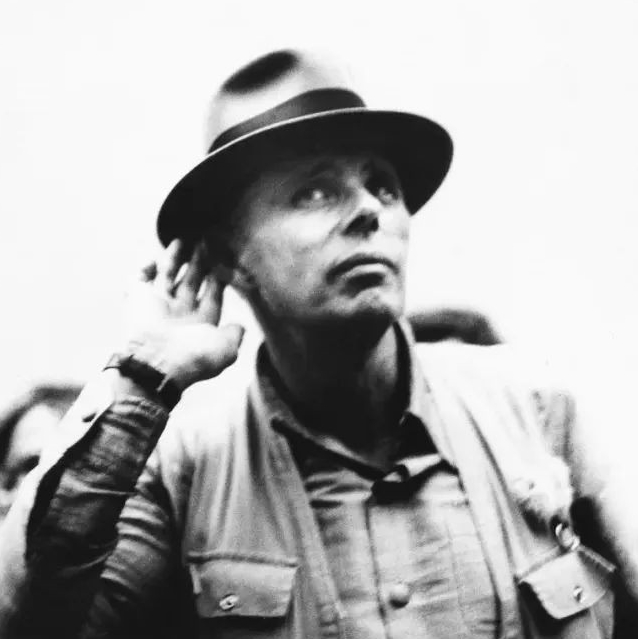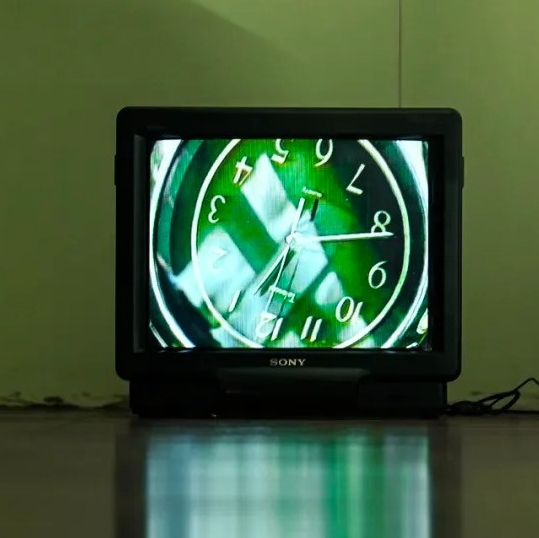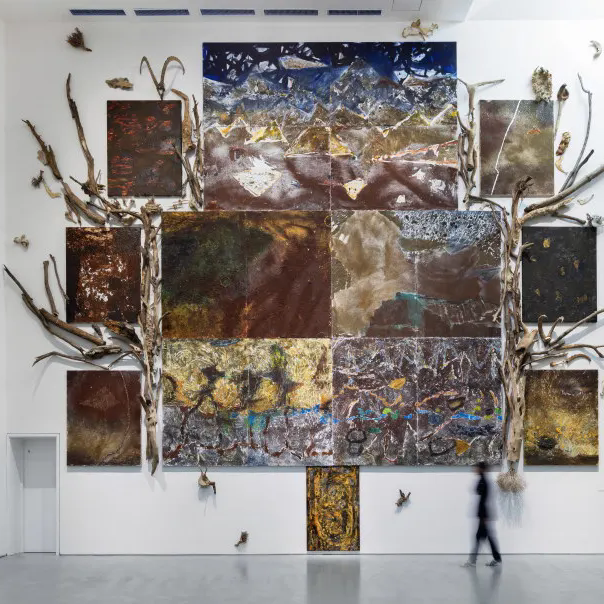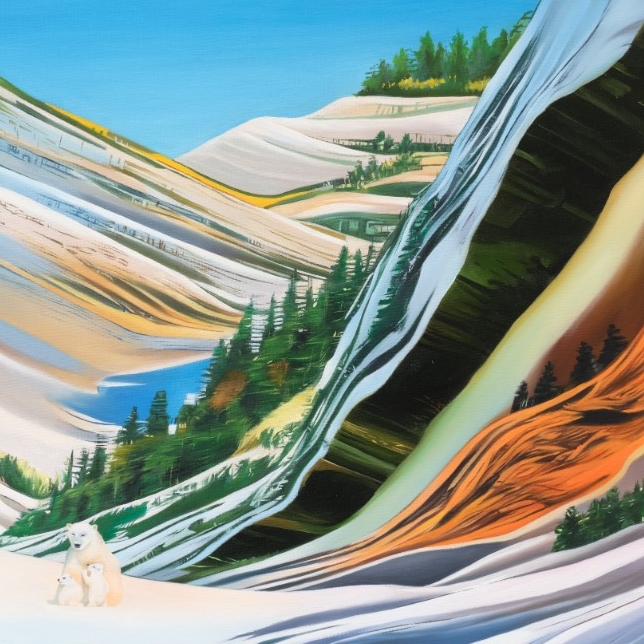From September 30, UCCA presents “Somewhere Downtown,” a group exhibition celebrating the creative ferment of Downtown New York in the 1980s and it spans various mediums including graffiti, painting, drawing, photography, film, sculpture, and installation.
The exhibition reveals the heights of expression that arose from within the urban landscape of America’s largest city at its economic nadir. Artists from vastly different backgrounds, working across a remarkable range of media, emerged in New York during this era and went on to become some of the most important artists of the late twentieth century.

Installation View. Courtesy UCCA Center for Contemporary Art. Photography by Sun Shi.
It features the work of icons such as Keith Haring, Jean-Michel Basquiat, and Cindy Sherman alongside that of lesser known trailblazers, many of whose art is being shown in China for the first time.The exhibition’s ten sections highlight different aspects of this extraordinarily vibrant period, including: “The City as Muse”, “Global Taste”, “Backlight”, “The Body in Crisis”, “The Scene”, “Shifting Identities”, “Myths and Archetypes”, “Curtain and Stage”, “The Future that Never Happened”, “Obsolete Creatures”.
Installation View. Courtesy UCCA Center for Contemporary Art. Photography by Sun Shi.
I. The City as Muse
As the exhibition co-curator Carlo McCormick comments, “We embarked on ‘Somewhere Downtown’ very much in the spirit of sharing, of trying to explain something about our experiences, our fears and our hopes, in the belief that the challenges we face and the way we try to deal with them are something people can find great common qualities in despite their differences. This period of the early 1980s in NYC was one of tremendous promise and problems, when a collective discontent with how things were done, in the arts and society, led to a questioning of the accepted or status quo, and an enthusiasm to find fresh directions. The past had begun to fail us—the great projects of Modernism, Industrialism, and Urbanism had come crashing down—and into this void of doubt, abandonment, and neglect a new generation stepped in with the remarkable energy that comes from the community as much as individuality.”
The advent of the 1980s saw America entering a conservative moment, a reaction to the urban unrest, protest movements, and economic crises of the 1960s and 1970s. As New York teetered on the edge of bankruptcy and crime soared in the 1970s, many middle-class white residents fled for the suburbs, leaving Downtown ripe for reinvention by its more deeply rooted communities (often racially and economically marginalized) and new arrivals (themselves escaping the parochialism of small-town America. “The City as Muse” showcases New York itself as a setting and subject, featuring art made and performed in public spaces by Diane Burns, Papo Colo, and Keith Haring; and scenes of the city by Jane Dickson and Peter Hujar, among others. Peter Hujar’s Trash, New York realistically reflects a specific scene at Downtown New York in the 1980s.

Peter Hujar (1934-1987), Trash, New York, 1985, pigmented ink print, 37.5 × 37.5 cm, edition of 10. © The Peter Hujar Archive, LLC/Artists Rights Society (ARS). Courtesy The Peter Hujar Archive, LLC and Pace Gallery, New York.
Installation View. Courtesy UCCA Center for Contemporary Art. Photography by Sun Shi.
Not far from Trash, York, is the Untitled (face) by Keith Haring, which was a spray paint on a postal truck roof. Also since 1980, the black idle billboards that can be seen everywhere in the New York subway have lured Keith Haring to create his iconic graffiti creation. “New York” is a direct source of materials, themes and inspiration for artists on the Lower East Side, not just a backdrop that provides an event scene, and other alternative spaces such as clubs, music scenes, bars, and other alternative spaces in Downtown New York City have become a gathering place for hip-hop musicians, musicians, graffiti masters, dancers, photographers, curators, collectors, and artists of all kinds.

Keith Haring (1958-1990), Untitled (face), 1982, spray paint on postal truck roof (metal), 213.4 × 190.5 cm. © Estate of Keith Haring. Licensed by Artestar, New York. Courtesy Private Collection, USA.
Charlie Aheam appeared in Wild Style, which was known as the first-ever “hip-hop movie” and told the story of two graffiti artists, Lee Quiñones and Fab 5 Freddy, who accepted the creative commission, and used the documentary quality of the video to create the real atmosphere of the streets of New York in the 1980s, which has a specific urban temperament. As Peter Eleey, another curator of the exhibition states, “New York opened itself up for art, and it was in this way that it catalyzed the development of art in New York.”

Installation View. Courtesy UCCA Center for Contemporary Art. Photography by Sun Shi.
Charlie Ahearn (b. 1951), Wild Style (Poster), 1983, video, 1.37:1, color, mono sound, 82'00". Courtesy the artist.
Charlie Ahearn (b. 1951), ROCK ON! (Busy Bee), Scratch Slide, c. 1980, Pigment print, 30 × 42 cm. Courtesy the artist.
Charlie Ahearn (b. 1951), Debbie Harry, Fab 5 Freddy, Grandmaster Flash, Chris Stein of Blondie, and Tracy Wormworth, c. 1980, Pigment print, 30 × 42 cm. Courtesy the artist.
Charlie Ahearn (b. 1951), King Kase, Fab 5 Freddy, Busy Bee, and Others, c. 1980, Pigment print, 30 × 42 cm. Courtesy the artist.
Charlie Ahearn (b. 1951), “Rapture” Video Shoot with Debbie Harry and Blondie with Lee Quiñones and Fab 5 Freddy Painting in the Background, c. 1980, Pigment print, 30 × 42 cm. Courtesy the artist.
Charlie Ahearn (b. 1951), Wild Style (video still), 1983, video, 1.37:1, color, mono sound, 82'00". Courtesy the artist.
Artists observe and examine the city from a variety of perspectives, and understanding the city is almost the same as understanding themselves. While Martin Wong’s Sharp & Dottie captures a heartwarming moment in the ruins of a city that is about to fall into depression, David Wojnarowicz chooses to find materials and inspiration on the streets, such as abandoned trash can lids, supermarket video posters or any waste from the streets. John Ahearn, who used plaster casts to produce statues of people around them in the city and left them in the community for people to appreciate.“Curtain and Stage” draws together works by Robert Kushner, Julian Schnabel, Laurie Simmons, and others that took a considered approach towards their backdrop, whether by referencing theater, dance, or the walls and subways on which graffiti first appeared.

Martin Wong, Sharp & Dottie, 1984, acrylic on canvas, 152.4 × 121.9 cm. Collection of KAWS. Courtesy the Martin Wong Foundation and P·P·O·W, New York.
Martin Wong (1946-1999), The Flood, 1984, acrylic on linen, 91.4 × 121.9 cm. Collection of KAWS. Courtesy the Martin Wong Foundation and P·P·O·W, New York.
Jane Dickson (b. 1952), Dreams Adult Bar, 1985, oil stick on red paper, 70.5 × 50.2 cm. Collection of KAWS. Courtesy the artist.
John Ahearn (b. 1951) and Rigoberto Torres (b. 1960), Maria Greeting Her Mother, 1988, oil on fiberglass, 129.5 × 132.1 × 121.9 cm. Courtesy of Alexander and Bonin, New York.
Installation View. Courtesy UCCA Center for Contemporary Art. Photography by Sun Shi.
Jean-Michel Basquiat (1960-1988), Old Tin ©, 1981, oil paint on wood, 73.7 × 45.7cm. Credit: Private Collection, USA. © Estate of Jean-Michel Basquiat. Licensed by Artestar, New York. Courtesy Private Collection, USA.
Jean-Michel Basquiat (1960-1988), Untitled (FOOL©), circa 1985, Xerox paper on wood, 25.4 × 20.3 cm. © Estate of Jean-Michel Basquiat. Licensed by Artestar, New York. Courtesy Private Collection, USA.
Jean-Michel Basquiat (1960-1988), Untitled (red face) , 1982, mixed media on paper, 17.8 × 12.7 cm. © Estate of Jean-Michel Basquiat. Licensed by Artestar, New York. Courtesy Private Collection, USA.
Jean-Michel Basquiat (1960-1988), Untitled (train), 1981, mixed media on canvas, 49.5 × 59.1 cm. © Estate of Jean-Michel Basquiat. Licensed by Artestar, New York. Courtesy Private Collection, USA.
II. The Night Scene
Confronted with isolation, Downtown New York artists in the 1980s spontaneously formed a loose but close-knit social network with gathering points in clubs, music scenes, and nightclubs. “Blacklight” features painting and sculptures that Keith Haring and Kenny Scharf created for nightclubs, illustrating how the art world melded together with a booming, queer-focused nightlife scene. In the face of tragedy, many sought refuge in the communal, as shown in “The Scene” through Maripol and Tseng Kwong Chi’s photographs of musicians, divas, and club-goers gathering together. These two sessions show the audience how their artistic practices reached beyond traditional exhibition spaces and converged with rapidly developing nightlife culture in 1980.
Installation View. Courtesy UCCA Center for Contemporary Art. Photography by Sun Shi.
Keith Haring (1958-1990), Untitled (Pop Shop 1), 1984, mixed media on board, 152.4 × 101.6 cm. © Estate of Keith Haring. Licensed by Artestar, New York. Courtesy Private Collection, USA.
Keith Haring (1958-1990), Untitled (Russian Doll), 1982, Day-Glo paint on wood, 82 × 64 cm. © Estate of Keith Haring. Licensed by Artestar, New York. Courtesy Private Collection, USA.
Keith Haring (1958-1990), Untitled (two yellow figures connected), 1983, Day-Glo paint on carved wood, 20.3 x 55.9 cm. © Estate of Keith Haring. Licensed by Artestar, New York. Courtesy Private Collection, USA.
This social network can be recognized as an art group such as the Colab, and the participating artists, including Charlie Ahearn, John John Ahearn, Jane Dickson, Jenny Holzer, Kiki Smith, Christy Rupp, Walter Robinson, etc. are all members of Colab. Their artistic practices were generally a culturally radical strategy, hoping to go beyond the traditional gallery system through diverse forms of practice such as creation and exhibition planning, responding to the general economic, cultural, and political conservatism of American society at that time, as well as some more pressing social issues, such as an increasingly gentrified New York that rose with consumerism.
Social networking also took place in the popular clubs in Downtown New York in the 1980s, such as Max's Kansas City, CBGB, Mudd Club and other popular locations in the city, they opened up to artists, musicians, curators, writers, as places of entertainment and exchange, but they can also be regarded as alternative spaces outside the gallery system. For example, filmmaker and curator Diego Cortez, who studied from Nam June Paik, is both the main operator of the Mudd Club and an important promoter of downtown New York artists and Keith Haring’s art space was also located in the Mudd Club, where the blacklight graffiti displayed in the exhibition has appeared in the club as decoration and self-presentation, making the club an experimental venue for various music, art, reading, fashion and dance performances.
Maripol (b. 1957), Madonna "Everybody", 1983, polaroid enlarged on Museum Canson paper, archival inks, 61 × 61 cm. Courtesy the artist.
Walter Robinson (b. 1950), Brats, 1984, acrylic on canvas, 61 × 61 cm. Courtesy the artist.
“Shifting Identities” places the stylized signatures of graffiti in the context of Ashley Bickerton’s work with corporate logos, Sturtevant’s repetitions of Keith Haring, and Lorraine O’Grady’s performances that challenged the construction and reception of Black identity in and beyond the art world.
Installation View. Courtesy UCCA Center for Contemporary Art. Photography by Sun Shi.
Jean-Michel Basquiat in collaboration with Keith Haring (1958-1990), ERO (1967-2011), Fab 5 Freddy (b. 1959), Futura (Leonard McGurr, b. 1955), Lady Pink (b. 1964), Eric Haze (b. 1961), LA II (b. 1967), Tseng Kwong Chi (1950-1990), Kenny Scharf (b. 1958), Rammellzee (1960-2010), Untitled (Fun Fridge), 1982, mixed media on refrigerator, acrylic, spray paint, ink marker, 143.5 × 61 × 64.8 cm. © Estate of Jean-Michel Basquiat. Licensed by Artestar, New York. Courtesy Private Collection, USA
III. From Downtown New York to the World
It is worth noting that the exhibition also has a perspective outside of New York. “Global Taste” demonstrates how Sarah Charlesworth, Louise Lawler, Martha Rosler, Laurie Simmons, and others appropriated images from art history, mass culture, and advertising to critique American consumer culture’s expansion at home and abroad.

Installation View. Courtesy UCCA Center for Contemporary Art. Photography by Sun Shi.
Inspired by the dollhouse, Laurie Simmons has shot a series of satirical works in conjunction with the emerging travel lifestyle. Martha Rosler’s three-channel video installation Global Taste (Three Courses and One Meal) provides an interesting contrast between food commercials, American television shows, and advertising auditions on three television screens and broadcast simultaneously to compare and conclude how “English as the language of power” can spread a homogenous Western neo-imperialist tendency by spreading the same “taste” based on globalization and mass media.
Another kind of reflection that goes beyond the geographical narrative appears in the sections “Myths and Archetypes” and “The Future that Never Happened.” The former brings together artists who have developed critical positions through the appropriation of images from American comics, pop-culture texts, and mythological stories; The latter sought to return to a historical perspective, in the face of the unfulfilled promises made by political propaganda in the 1980s and equally unfulfilled images of the “space age”; they both give play to their futuristic artistic imagination in the reflection.

Installation View. Courtesy UCCA Center for Contemporary Art. Photography by Sun Shi.
Between a nostalgic attachment and a sarcastic rejection, the inner ambivalence of a generation lingers in their paintings full of retrospective and imaginary futures, as Carlo McCormick, one of the curators, shared in a brief opening conversation: “When we look back at mythology, like ‘the great American cowboy’ or something like that, or modernism, we find that these things still resonate.” It’s a bit like admiration, followed by rejection, of course. It is in this process of contradiction that many contradictory works are born. These works both ridicule Hollywood mythology but also have a great attachment to Hollywood mythology, incorporating romanticism into cynicism.” Soon with the 1990s, a new digital model driving the global economy officially arrived, the street culture created by artists in Downtown New York was gradually accepted by both the art system and the commercial system, the internet space flourished, and the dilapidated public space in New York inevitably moved towards gentrification. Unconsciously, the Lower East Side of New York with artists living there have become a new myth.
Text (CN) by Mengxi, edited by CAFA ART INFO.

































